|
Caveman movies, as they are sometimes quaintly classified, are not generally renowned for their historical accuracy. In Hammer's entertaining 1966 opus One Million Years B.C., a fur bikini-clad Raquel Welch and some modern-looking men with scruffy hair and beards battled creatures that had by then been extinct for something like sixty million years. In the hilarious 1958 The Wild Women of Wongo, the all female tribe (one wonders how they reproduced) appears to have stepped straight out of a Californian beauty parlour, a characteristic that also distinguished the angry Stone Age feminists in the 1950 Prehistoric Women.* Often this sizeable and important slice of human history has been played purely for laughs, as in Mel Brooks' A History of the World: Part 1 (1981), Carl Gottlieb's Caveman (also 1981 – there must have been something in the water) and Harold Ramis' Year One (2009). Historically sound these films were not.
For many years the most convincing portrait of our primitive past selves was not a stand-alone film, but the mesmerising first chapter of Stanley Kubrick's 2001: A Space Odyssey, which effectively threw down a gauntlet of realism that few were prepared to pick up and run with. Hammer gave it a surprisingly decent bash in 1971 with Creatures the Woirld Forgot, but in the same year as the above-listed comedy takes, French director Jean-Jacques Annaud delivered an ambitious adaptation of the 1911 novel by J.H. Rosny Sr., the pseudonym adopted by Belgian authors Joseph Henri Honoré Boex and his brother Séraphin Justin François. Annaud had already made a splash on the international circuit with his 1976 debut feature Noirs et blancs en couleur [Black and White in Colour], which bagged him the Best Foreign Language Film Oscar, but studio investors were not exactly beating a path to his door to fund a film set in Palaeolithic Europe with no comprehensible dialogue and a cast of visually unattractive unknowns.
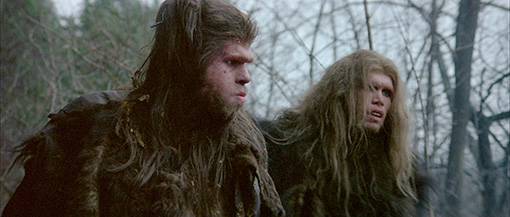
Annaud took his desire for realism seriously, selecting actors for their simian features and their way with body language, hiring respected linguist and Clockwork Orange author Anthony Burgess to devise the primitive dialects and noted ethologist and Man Watching author Desmond Morris to create authentic-looking gestures. Circus elephants were costumed up as mammoths, tusks were fitted to lions to create their sabre-toothed ancestors, and a range of unspoilt and visually primeval international locations were scouted and secured for filming. Even the design and construction of the costumes and makeup were tested and extensively reworked until Annaud was fully satisfied with the results. This perfectionism paid off in the shape of the most convincing portrait of prehistoric man yet committed to film, one that is still without peer thirty-two years after it was first released. And yet nestled within is a tale almost as old as storytelling itself.
80,000 years ago, the possession of fire was a symbol of power and a means of survival. In the harsh environment of prehistoric Europe, the Homo sapien Ulam tribe keep a flame alive in a small bone cage, from which they are able to start larger bonfires for warmth and to cook slaughtered meat. When their camp is attacked by the Neanderthal Wagabu, the survivors flee and take refuge on marshland, a journey that results in the flame being accidentally extinguished. Facing possible death from exposure and starvation, the Ulam elder sends tribesmen Naoh (Everett McGill), Amoukar (Ron Perlman) and Gaw (Nicholas Kadi) on a quest to locate a new source of fire and rekindle the flame on which their survival depends.
What unfolds has many of the elements of the classic adventure story as defined by Joseph Campbell in A Hero's Journey. From an early stage the trio have a natural leader in the authoritative Naoh, who is sent on a quest by the community leader, one that proves to be littered with obstacles. The hero and his sidekicks engage in battle with Neanderthal cannibals, flee from a pair of sabre toothed tigers, and engage in climactic combat with their own tribal rivals. They even get to rescue a damsel in distress in the shape of Ivaka tribeswoman Ika (Rae Dawn Chong), who has been captured by the cannibals and strung up for food. It's she that effectively drives the story's second half, as she emotionally bonds with Naoh to such a degree that instead of returning the flame to the Ulam people, he pursues her to her tribal home, where he encounters a people whose advanced development is set to change the future of his own tribe forever.
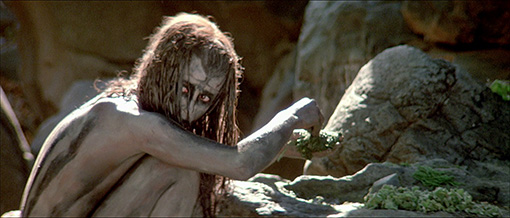
Recognisable though the touchstones may be, the requirement that we interpret information from expressions and body language (aided by Philippe Sarde's sometimes majestic score) without the usual crutch of intelligible dialogue presents familiar elements from an unfamiliar viewpoint, rendering them disarmingly fresh by default. This is enhanced by the veracity of the lead performances. The ape-like movements and gestures never play as parody and Ika's screeched but initially unintelligible chatter is always convincing – we, like the Ulam, may not understand what she is trying to tell us but she clearly does, creating a palpable sense that every word she says has specific meaning and intent.**
Annaud's impressively and appropriately low-key approach also allows him to incorporate small comic asides – most of which seem to involve Ron Perlman's none-too-sharp Amoukar – without seriously disrupting the sense that what we're watching is grounded in reality. This is enhanced by the extraordinary vistas in which the action unfolds, the scene-by-scene moves between locations as far apart as Scotland, Canada and Kenya rendered invisible by the consistency of Claude Agostini's sometimes breathtaking scope cinematography. Yet the most memorable encounter is one of the least visually dramatic, as an Ivaka tribesman demonstrates to an increasingly astonished Naoh the seemingly magical process of actually creating fire. It's a skin-pricklingly effective and emotionally thrilling scene that perfectly encapsulates the gentle majesty of Annaud's approach, with documentary realism (the Ivaka is played by a Kenyan Masai tribesman, who creates fire for real in the manner his people have employed for centuries), an impeccably emotive use of music and some superb reactive acting by Everett McGill transforming a seemingly simple sequence into one of almost epic revelation.
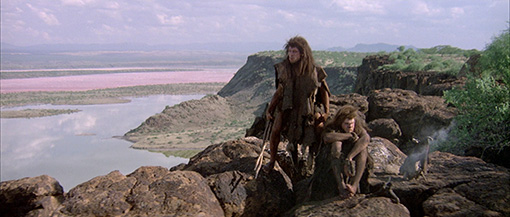
Contemporary theories on the development of humankind do put Annaud's timeline out by something like 40,000 years and possibly more, as the migration of Homo sapiens to Europe is now thought to have occurred considerably later than originally believed. Where modern ethnological thinking does support Annaud and Morris is in the suggestion that Homo sapiens and Neanderthals co-existed, through I still struggle with the idea that the Ulam could learn the concept of humour simply by being exposed to the more advanced Ivaka. Some earlier reviews also mocked the sexual element, particularly the suggestion that the missionary position led directly to love and monogamy, though even this has been given a degree of credence by theories concerning the emotional bond created by being face-to-face during the sexual act.
When Quest for Fire first hit UK cinemas, the viewing public had seen nothing quite like it, and thirty-two years on it remains a rare and captivating film experience. It's a project that would never have seen the light of day were it not for Annaud's single-minded passion and determination and the faith and conviction of his key collaborators. And despite its conventional narrative structure, it's still an utterly enthralling work, one that launched the careers of leading players and cemented Annaud's reputation as a filmmaker of rare and distinctive vision.
I was keen to see how Quest for Fire would shape up on its first UK HD incarnation, given how good the Twentieth Century Fox's 2003 US DVD looked on its release. Second-Sight's Blu-ray certainly equals that transfer's nicely balanced contrast and pleasing colour palette, and as you would hope the image is sharper and there is a lot more visible picture detail here. This does, however, vary on a sometimes shot-to-shot basis, as does the level of visible film grain, which really stands out when the light levels drop. At its best – usually in the open when the sun is up – the transfer shines and for picture detail alone leaves the DVD standing, though traces of what looks like minor edge enhancement are visible on one of the screens I watched the disc on. It's worth noting that the soft appearance of one key shot – Naoh's reaction to being shown how to make fire – is revealed in the extras to be the result of a technical glitch when filming and Annaud being unable (and unwilling, given McGill's spot-on performance here) to go back and shoot the sequence again.
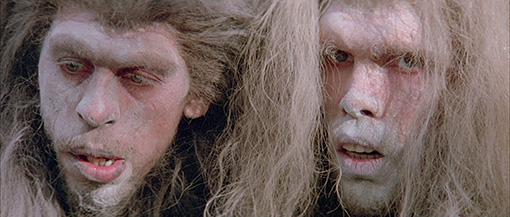
There's a choice of soundtracks between Linear PCM 2.0 stereo and DTS-HD Master Audio 5.1 surround. Given the film's age and the slight restrictions on the dynamic range, it seems likely that the stereo is the closest to the original track, but the DTS surround, though front-weighted for dialogue and music, makes decent use of the rear speakers for the sound of ambient wildlife, wind and rain. Both tracks are clear and free of damage and background hiss.
If you already own the 2003 Fox DVD mentioned above then you'll be familiar with all of the extra features here, which have been ported over from that release. This is not an issue given their quality and the sense of completeness they bring to the package, and if you don't own that disc they should prove doubly welcome.
Jean-Jacques Annaud commentary
One of those absolutely spot-on commentaries that provides detailed answers to just about every question you'd want to ask Annaud if you were watching the film with him. He wastes no time on vanity comments or describing or analysing what's happening on screen and instead delivers a wealth of background information on the production and shooting of specific scenes. Delivered in clear English with hardly a pause for breath, the wide range of subjects covered include the studio's problem with the pronunciation of his name, selecting the locations, devising the languages, getting the casting right, the music score, the detailed preparatory research, working with tigers and elephants, casting Rae Dawn Chong, the difficulties raising finance, the technical problems with the pivotal fire-making scene and the studio's belief that the film didn't need it (are you kidding me?), and absolutely loads more. One of my favourite stories involves the post-production work required to darken the picture when, due to exhaustion, director of photography Claude Agostini forgot the escape scene they were shooting was supposed to be taking place at night.
Rae Dawn Chong, Ron Perlman and Michael Gruskoff commentary
A lot less detailed than the previous track but still an informative and entertaining listen, producer Michael Gruskoff and actors Ron Perlman and Rae Dawn Chong recall their time working on the film. There's a bit too much jocular commenting on the action, the sort often made by people who won't just shut up and watch the damned movie, but there's also plenty of interesting info on the experience of working under sometimes extreme conditions. Rae Dawn Chong openly admits that she was not happy with some of the things she was required to do but that she was perfectly comfortable being naked (something she believes helped her land the role), and all three were pleased with the completed film and their work on it. They also provide alternative takes on stories from Jean-Jacques Annaud's commentary and a couple of times contradict Annaud's version. Stick with the end credits for Ron Perlman's story about briefly meeting Orson Welles.
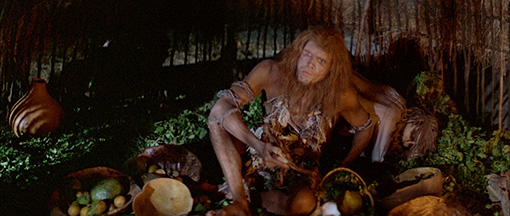
Interview with Jean-Jacques Annaud (33:06)
Recorded in 2002, this interview with Annaud was conducted in his native French, which allows him to speak even faster than he does in English, making for an information crammed thirty-three minutes. The process of getting the film off the ground and some stories of the shoot are repeated from elsewhere but considerably expanded on, providing some of the most detailed recollections on the entire disc. The problems of securing funding is especially well covered and I was particularly enthralled to learn that the elephants had to spend five hours in makeup to transform them into mammoths. In guessing the interview was originally designed to be shown letterboxed on a 4:3 screen, resulting in a picture here that is seriously windowboxed on all four sides.
The Making of Quest for Fire (24:49)
Shot and assembled during the film's production, this is a welcome peek behind the scenes and includes brief interviews with the younger Jean-Jacques Annaud and actors Ron Perlman, Everett McGill, Nicholas Kadi and the lovely Rae Dawn Chong, who neatly sums up her positive attitude to nudity with the observation that "it's where we all started and where we should stay." Absolutely. Particularly interesting are the interviews with Anthony Burgess and Desmond Morris and the footage of them working with the supporting cast. There are no name captions, though, so you need to be able to recognise the faces to identify who is speaking, easier with the actors than some of the filmmakers.
Video Gallery with Jean-Jacques Annaud commentary (48:01)
Divided into 15 sections of differing length that will play continuously forward from whichever one you select, this extra is made up of artwork, documents and a wide range of photographs, with background on each provided by director Annaud. The section titles are: Inspiration; Locations – Iceland (the photos here show just how good the locations here would have been); Locations – Kenya; Storyboards; Inspiration for Sets (which actually talks about costumes); Set Design; Prop Design; Casting & Training (some interesting rehearsal photos here); Costumes; Make-up; Burgess Dictionary (I'd like to have had this as a booklet or PDF); Mammoths; Behind the Scenes; Production Shots; and Promotion. Lots of really interesting stuff here, particularly of material showing the development of costumes and makeup and the wealth of info provided by Annaud's narration.
Coming back to the film after a ten-year break I was genuinely surprised how caught up I still became in what in some ways is a by-the-book melding of classic adventure trek tale and uncomplicated love story. But so convincing is the world created by Annaud and his collaborators and so finely nuanced the characters and performances that they make it feel like we're watching this story for the very first time, which in terms of perspective and specific detail we probably are. Second Sight have once again done a solid job here, with a generally good transfer and all of the extra features from the 2003 region 1 DVD. It thus has to come warmly recommended.
* After watching One Million Years B.C. and Prehistoric Women as part of their film research, Annaud actually considered giving up on the project.
** Anthony Burgess created a dictionary of 300 words for the spoken languages here, each with specific meaning and shaped by his own extensive knowledge of ancient dialects. The actors were required to learn the whole vocabulary and having done so were able to improvise lines that made linguistic sense.
|